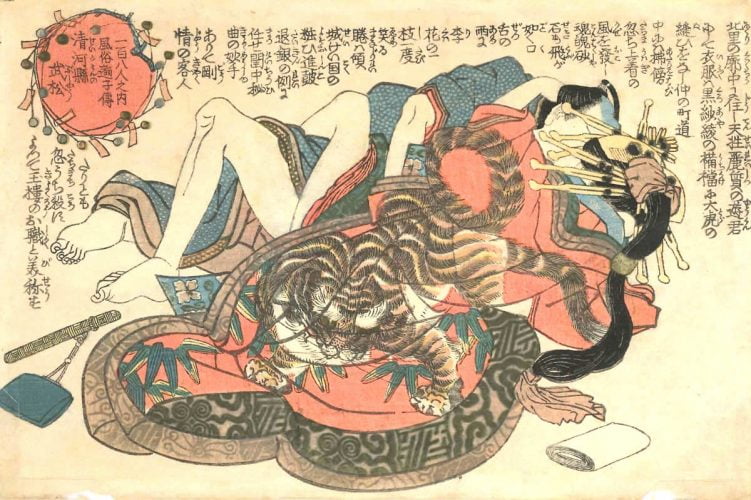“I thought the Japanese were into understatement”
Free from guilt or sin, the erotic art of Japan was a source of sexual stimulation, instruction and a ribald earthy humour. At its core, it glamourised the human body, primarily the actor celebrities of the Kabuki theatre and the courtesans of the Pleasure Quarters; the exaggerated dimensions of the genital organs an expression of their role as objects of sexual fantasies and of heightened pleasure.
The erotic art of the great Uliyo-e artists of Japan has, over the past few decades, become recognised as one of the greatest evocations of sensual pleasure in world art. The work of lesser artists, on the other hand, may well qualify for the critical judgement of a former curator of the Victoria and Albert Museum who described the imagery as being ‘quite beyond all Europeans canons of good taste’.
Originally, created in book or album form as an aid to sexual pleasure and technique, these images were created by all the great Ukiyo-e artists of the Edo period (1603 – 1864). In the absence of a concept of pornography the sexual explicit imagery in these books was not considered obscene or puerile, but, rather, a legitimate subject for the artist.
Called ‘shunga’ (Spring Pictures), they were first, and more realistically, known as makura-e (the Pillow Book) because of the role they played in stimulating sexual arousal and experimentation. Frequently shown in the images themselves these manuals were much in demand and much used.
Growing out of the popularity of novels of erotic experience and amorous intrigues, Pillow Books took as their inspiration the stories of the Kabuki theatre as well as the famous courtesans of the pleasure quarter, the Yoshiwara. Indentured to the licensed ‘Green Houses’ at an early age, the most gracious, learned and skilled courtesans attracted the attention enjoyed by the ‘super models’ and film stars of the 20th Century. Their beauty and skills were the subject material for the great artists of the day. Only in the violence depicted in some of these books is there any reference to the darker side of what would now be called the sex industry: the virtual imprisonment of the women in the Yoshiwara from a very early age and, abandonment when their looks faded in their mid-twenties.
Banned when Japan turned to the West in the mid 19th Century, thier production was partially tolerated during the Sino-Japanese War (1894 95) and the Russo-Japan War in 1904 as a ‘comfort’ to the troops. Examples of these are to be found in this exhibition. The reproduction of shunga for art books and catalogues was only allowed at the very end of the 20th Century.
Eight of the prints are from the collection of Western Australian, Noel Montague who is currently being treated for advanced dementia in a wonderful facility in Thailand. The proceeds of the sale of these prints will help in funding his care. (see prints marked NM)
WARNING
Because of the nature of this work, the exhibition is housed in the side gallery of Kidogo separately from the exhibitions of drawings by Julie Podstolski and the ceramics of Stewart Scambler. Viewers are warned that this exhibition contains graphic images of sexual intercourse and adult themes which may cause offence . The exhibition is not suitable for minors without parental guidance.
For further information, please contact David Forrest on 0405 698 799

